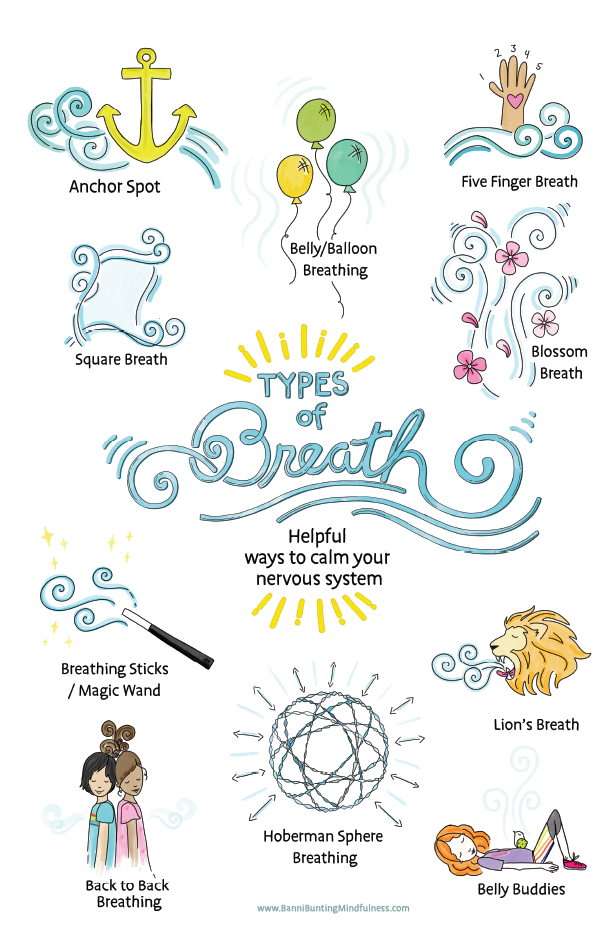Breathing Techniques
daily-practices-breath
The Importance of Breath
Breathing is a foundational practice of mindfulness, a way of anchoring our attention and steadying the mind. And breathing is something we do roughly 26,000 times a day without much thought, but it effects our entire being. Breath is life. It is the first thing we do on when we arrive on this planet and it will be the very last thing we do. Our breath is an important tool for self-regulation and self-awareness, especially if we can remember to use it. The breath is an effective away of calming our nervous systems and bodies taking us from our parasympathetic nervous system, our flight, fight or freeze response and back to our sympathetic nervous system.
When engaged in mindful breathing, a good habit to incorporate towards the end of the practice is to invite the students to notice how they feel internally, what is it that they feel in the present moment. Be curious and notice howa few short moments of mindful breathing, can make you feel more relaxed, more settled, more balanced, and possibly more calm.
Ten Mindful Breathing Practices
1.Anchor Spot - An anchor spot is the place where we feel our breath most strongly or distinctly. Typically, there are three main areas for focusing on the breath: (1) base of the nose, (2) in the chest and torso, or (3) in the belly. But as you become more familiar with experiencing your breath, one can feel their breath throughout their entire body as we become more aware of the subtleties in the body.
2.Belly/Balloon Breathing - Belly breathing is learning to connect to the feelings and sensation of breathing in the stomach area. This type of diaphermatic breathing calms the nervous system, a wonderful tool for self-regulation and self-awareness
3.Breathing Stick/Magic Wand - Breathing sticks are an easy way for the students to connect to their breath; both visually and sensing the breath in their body. Each of the five beads on the stick represent one complete breath. The students take one slow, deep breath as they move one bead across the stick. Science has proven 5 diaphermatic breathes can calm our nervous systems from our sympathetic to our parasympathetic nervous system.
4.Blossom Breath - Start by placingthe palms together in front of the heart.Take a slow, deep breath in through the nose and then pause when the lungs are full. Holding the pause and the breath momentarily, then send the palms and arms up over head and as you slowly exhale, send your breath out all around you as you extend your arms wide to the sides and then palms back together in front of the heart. Repeat with each breath.
5.Square Breath - With each round of breath, students will draw a complete square on their palm with each breath. With an inhale, draw up one side of the square. Pause and retain the breath, as you draw across the top side of the square. Exhale slowly as you draw down, creating the third side of the square. Pause again and retain the breath as you finish the square by drawing across the palm, the bottom side of the four-sided square. Repeat with each breath
6.Five Finger Breath - Using the index finger of one hand and spreading the fingers wide open on the other hand, trace over one finger with one breath. With the second breath, slowly trace over the next finger. Continue this with each finger, completing five slow, deep breathes and tracing over all five fingers. Remember science shows that five slow deep belly breaths help calm our nervous system and helps return us to our “wise owl” brain.
7.Hoberman Sphere Breathing - The Hoberman Sphere provides a wonderful visual connection to the breath. The sphere expands with each inhale and contracts with each exhale in an accordion-like manner. Rhythm and speed are two keys to using a breathing sphere effectively, slow and steady.
8.Lion’s Breath - A breathing technique suited for releasing energy and pent up emotions and feelings. Taking a slow, deep inhale through the nose and then opening the mouth releasing the exhale as you stick out the tongue, stretching all the muscles in the face, and making the sound “haaaaah”.
9.Belly Buddies - Lie down on your back using a small, soft object to connect with the felt experience of breathing. Feel the toy rise with each inhale and fall with each exhale.
10.Back to Back Breathing - With a partner, sit back to back, and begin to slow and deepen each breath. Notice your own breath as well as your partners breath. Be curious about sensations, movements, rhythms and pacing and sit with your back resting against theirs.

